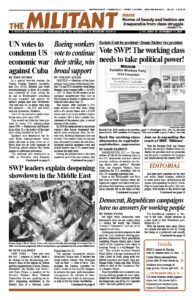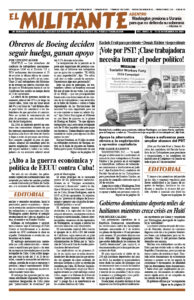November 15, 1999
NEW YORK — The crash of Egypt Air’s Flight 990 from New York to Cairo, which killed all 217 passengers and crew members, has highlighted once again the disregard of the airline bosses and aerospace manufacturers to safety in the air. The New York Post and some other big-business media have struck an antilabor note in writing about the Boeing 767 plane.
Post staff writer Bill Sanderson pointed out that when the plane was built Boeing Machinists were preparing to go out on strike, and did so on Oct. 4, 1989. The headline read, “Jetliner built during a time of labor strife.”
Sanderson wrote, “In addition to the money, a major issue in the 48-day strike was the heavy amount of overtime required of production workers, many of whom complained of being too tired to do their jobs properly.” Some television reports raised similar innuendo.
November 15, 1974
HOUSTON — In an ominous escalation of the drive against undocumented workers, U.S. Attorney General William Saxbe has called for the deportation of one million “illegal aliens.” Playing on the fears created by the mounting recession, Saxbe asserted that the presence of undocumented workers constitutes a “severe national crisis.”
When the economy is on the upturn the undocumented workers are permitted to slip across the border to fill the hardest, dirtiest, lowest-paying jobs. With the economy sinking the drive is on to get rid of the “surplus” and make the victim the criminal.
Mass deportation of the undocumented will not bring better jobs, schools or homes. It will not bring unionization to agriculture. It will only create the kind of division that capitalism consciously promotes in order to intensify oppression and exploitation.
November 14, 1949
The people of Harlem are ready to fight against police brutality whenever they get a chance. They showed this once again when the police broke up a parade for Benjamin Davis, the Stalinist candidate for City Council. The cops charged the crowd, not only the paraders but everyone on the sidewalks.
At this point the people living in the adjacent buildings entered into the picture. They had been looking out of their windows, attracted by the music of the sound trucks. But what they saw taking place before their eyes — a brutal police attack on defenseless people — is an old and familiar story in Harlem, and it moved them to action.
Bottles, tin cans and other household implements began pouring out of the windows and off the roofs. It was a spontaneous action by the residents and all the more revealing of the people’s hatred of police brutality.

